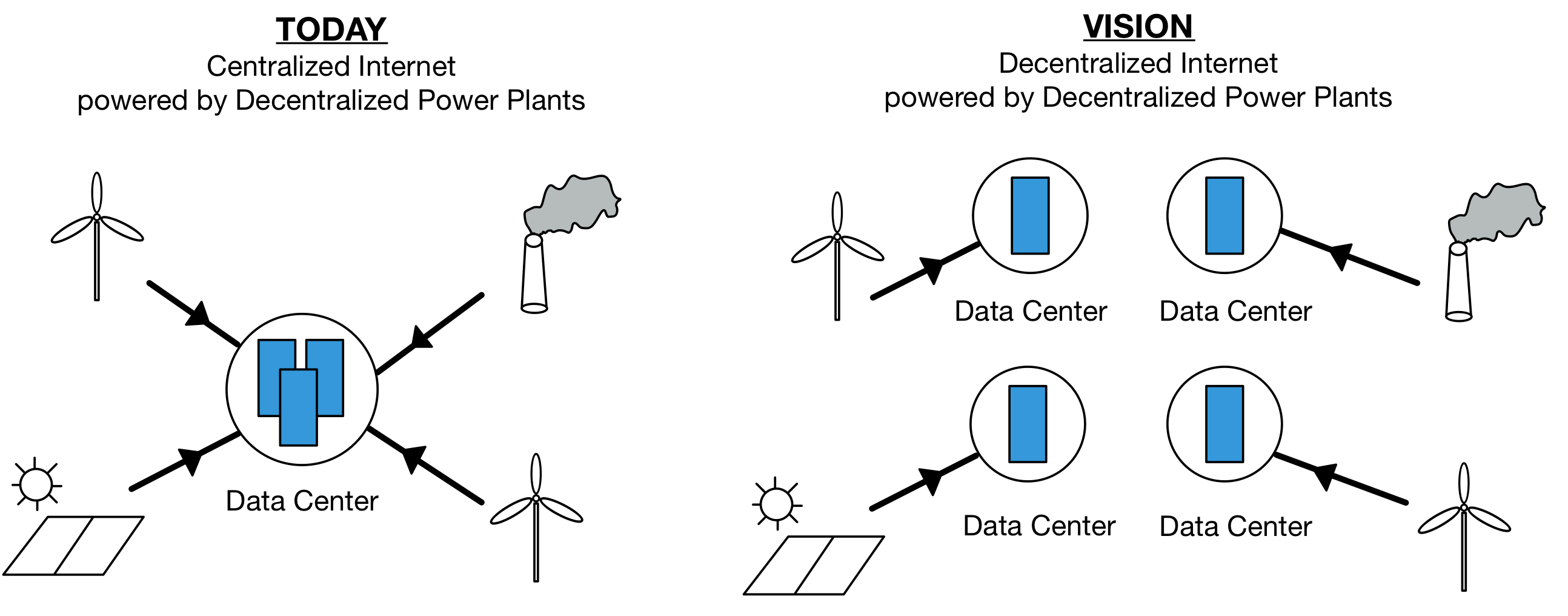The electricity consumption of data centers has been continuously increasing. For example, in Ireland, data center electricity use tripled from 5% in 2015 to 14% in 2021. In West London, there is no capacity in the electricity grid to power new houses due to the data centers consuming all the available electricity.
Computer and Electricity Networks: Moving in Opposite Directions
At its inception, the Internet was decentralized, a network connecting personal computers running in universities and hobbyists’ garages. The fundamental principle of the Internet was its resilience, a decentralized computer network designed to operate despite any failures in its nodes or network connections.
Today, the Internet is becoming a centralized computer network as a few gigantic cloud data centers replace many smaller ones worldwide. The recent outages at cloud data centers (like AWS and Google Cloud) almost halted the Internet, proving it is less resilient to failures because it evolved to a centralized network with most software applications hosted in a few hyper-scale data centers.
In parallel, the electric power industry has been moving in the opposite direction, transforming from a centralized electricity network of a few massive power plants (like coal and nuclear) to a decentralized network of smaller power plants (like wind and solar).
A Holistic View of Energy Efficiency: Distributing Electricity From Power Plants to Data Centers
One of the main drivers for cloud migration is the higher energy efficiency of cloud hyper-scalers than on-premises data centers. We measure their efficiency using the ratio of total energy consumed by a data center (for cooling, lights, and computing equipment) to the energy consumed by the computing equipment, known as the Power Usage Efficiency (PUE):
PUE = Energy consumed by Data Center / Energy consumed by Computing Equipment
For example, on-premises data centers have a PUE of around 1.5 or higher, whereas cloud providers have a 1.2-1.4 (a lower PUE is better, indicating a more energy-efficient data center).
However, looking only at the data centers’ efficiency is shortsighted. Given their high electricity consumption, we must examine how electricity gets produced and distributed to data centers.
Today, the smaller power plants around a hyper-scale data center cannot cover its high electricity demand, thus having to transfer electricity from far away. We must often import energy from neighboring countries to power cloud data centers due to their excessive need for electricity. When transferring electricity over an increased distance, the energy losses are higher. Moreover, significant investments are needed to augment the power grid’s capacity to carry increasing amounts of electricity to hyper-scale data centers.
For example, India has power transmission and distribution losses of 19%. Assuming a centralized power plant produces 1.000Wh of electricity and transfers them over the grid, approximately 1.000Wh x (100%-19%) = 810Wh will be delivered to a cloud data center. Given that a cloud provider like Microsoft Azure has a PUE of 1.4 in the Asia-Pacific, the electricity to be consumed by the computing equipment will be: 810Wh / 1.4 = 578Wh

Thus, the overall power usage efficiency from the power plant to the computing equipment of the cloud data center will be: 1.000Wh / 578Wh = 1.73
The electricity losses for distribution over long distances and the much-needed capacity upgrades of the power grid imply a high sustainability cost that could defeat the purpose of using more efficient cloud data centers.
Instead, we could have a smaller data center with a PUE of 1.5, powered by a nearby plant, such as solar panels on the roof of the building hosting the data center. In that case, there wouldn’t be any transmission and distribution losses. Assuming 1.000Wh generated by the solar panels, the computing equipment would consume: 1.000Wh / 1.5 = 666Wh, thus making more efficient use of the produced electricity.
When we factor in the power transmission and distribution losses, smaller, distributed data centers can be more sustainable than established hyper-scale data centers.
Looking Ahead to a Sustainable Internet
An alternative, more sustainable solution would be having smaller data centers next to smaller power plants (like solar and wind), eliminating the need to carry electricity over long distances. Even though these small data centers may not be as efficient as the cloud hyper-scalers, their total electricity consumption could be less than the cloud hyper-scalers since the limited losses for energy distribution can compensate for limited energy efficiency.

Transitioning to an internet with multiple smaller geographically distributed data centers means that data consumers (e.g., video streaming applications running on laptops) and producers (e.g., IoT devices) will likely have a data center in proximity. Thus, data transmission networks will consume less energy because data will cover shorter distances to and from data centers. That’s another reason why smaller distributed data centers are more sustainable.
Moreover, establishing small, decentralized data centers will make the Internet more resilient because a failure in a small data center will have a limited blast radius.
While we will continue to have large-scale power plants and data centers in the foreseeable future, a sustainable strategy calls for establishing many smaller data centers next to the small photovoltaic and wind power plants. This approach will:
- Allow for a leaner power grid since each power plant will sufficiently power the nearby small data center.
- Reduce the overall electricity demand from data centers by minimizing the power transmission and distribution losses to nearby data centers compared to the losses when powering far-away hyper-scale data centers.

